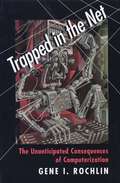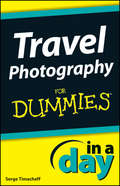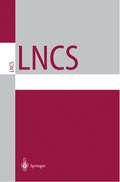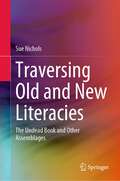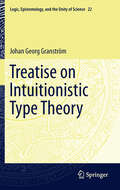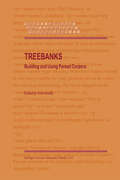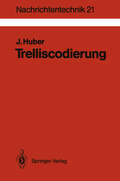- Table View
- List View
Trapped in the Net: The Unanticipated Consequences of Computerization
by Gene I. RochlinVoice mail. E-mail. Bar codes. Desktops. Laptops. Networks. The Web. In this exciting book, Gene Rochlin takes a closer look at how these familiar and pervasive productions of computerization have become embedded in all our lives, forcing us to narrow the scope of our choices, our modes of control, and our experiences with the real world. Drawing on fascinating narratives from fields that range from military command, air traffic control, and international fund transfers to library cataloging and supermarket checkouts, Rochlin shows that we are rapidly making irreversible and at times harmful changes in our business, social, and personal lives to comply with the formalities and restrictions of information systems. The threat is not the direct one once framed by the idea of insane robots or runaway mainframes usurping human functions for their own purposes, but the gradual loss of control over hardware, software, and function through networks of interconnection and dependence. What Rochlin calls the computer trap has four parts: the lure, the snare, the costs, and the long-term consequences. The lure is obvious: the promise of ever more powerful and adaptable tools with simpler and more human-centered interfaces. The snare is what usually ensues. Once heavily invested in the use of computers to perform central tasks, organizations and individuals alike are committed to new capacities and potentials, whether they eventually find them rewarding or not. The varied costs include a dependency on the manufacturers of hardware and software--and a seemingly pathological scramble to keep up with an incredible rate of sometimes unnecessary technological change. Finally, a lack of redundancy and an incredible speed of response make human intervention or control difficult at best when (and not if) something goes wrong. As Rochlin points out, this is particularly true for those systems whose interconnections and mechanisms are so deeply concealed in the computers that no human being fully understands them.
Trapped in the Net: The Unanticipated Consequences of Computerization
by Gene I. RochlinVoice mail. E-mail. Bar codes. Desktops. Laptops. Networks. The Web. In this exciting book, Gene Rochlin takes a closer look at how these familiar and pervasive productions of computerization have become embedded in all our lives, forcing us to narrow the scope of our choices, our modes of control, and our experiences with the real world. Drawing on fascinating narratives from fields that range from military command, air traffic control, and international fund transfers to library cataloging and supermarket checkouts, Rochlin shows that we are rapidly making irreversible and at times harmful changes in our business, social, and personal lives to comply with the formalities and restrictions of information systems. The threat is not the direct one once framed by the idea of insane robots or runaway mainframes usurping human functions for their own purposes, but the gradual loss of control over hardware, software, and function through networks of interconnection and dependence. What Rochlin calls the computer trap has four parts: the lure, the snare, the costs, and the long-term consequences. The lure is obvious: the promise of ever more powerful and adaptable tools with simpler and more human-centered interfaces. The snare is what usually ensues. Once heavily invested in the use of computers to perform central tasks, organizations and individuals alike are committed to new capacities and potentials, whether they eventually find them rewarding or not. The varied costs include a dependency on the manufacturers of hardware and software--and a seemingly pathological scramble to keep up with an incredible rate of sometimes unnecessary technological change. Finally, a lack of redundancy and an incredible speed of response make human intervention or control difficult at best when (and not if) something goes wrong. As Rochlin points out, this is particularly true for those systems whose interconnections and mechanisms are so deeply concealed in the computers that no human being fully understands them.
Travel Behavior Characteristics Analysis Technology Based on Mobile Phone Location Data: Methodology and Empirical Research
by Fei Yang Zhenxing YaoThis book is devoted to the technology and methodology of individual travel behavior analysis and refined travel information extraction. Traditional resident trip surveys are characterized by many shortcomings, such as subjective memory errors, difficulty in organization and high cost. Therefore, in this book, a set of refined extraction and analysis techniques for individual travel activities is proposed. It provides a solid foundation for the optimization and reconstruction of traffic theoretical models, urban traffic planning, management and decision-making. This book helps traffic engineering researchers, traffic engineering technicians and traffic industry managers understand the difficulties and challenges faced by transportation big data. Additionally, it helps them adapt to changes in traffic demand and the technological environment to achieve theoretical innovation and technological reform.
Travel Photography In A Day For Dummies (In A Day For Dummies)
by Serge TimacheffTake better travel shots on your next vacation with this terrific, 100-page e-book! From pro to hobbyist, from short weekends to dream vacations, every photographer wants to be able to capture memorable and compelling travel photos. Now you can hit the road with this fast-paced, In A Day For Dummies e-book that really zeros in on how to best capture eye-popping travel photos. Find out how to set your camera, make adjustments on the fly, prepare for all kinds of light--even get great shots with your smartphone. You'll go through this handy e-book in a day, and capture photos for a lifetime. Focuses on techniques for capturing fantastic travel photos, no matter where you are or what kind of camera Covers setting the camera for the shot, making adjustments on the fly, lighting and composition, using a smartphone camera, and editing and sharing your photos Includes a "Beyond the book" online component, where you can find step-by-step tutorials, videos, and a bonus lesson on creating a high-dynamic range travel photo Online extras also include a photo book, how to make money selling your photos, and a gallery of unique travel photos to inspire you Get Travel Photography In A Day For Dummies, grab your camera, and hit the road!
Travel Photography In A Day For Dummies (In A Day For Dummies)
by Serge TimacheffTake better travel shots on your next vacation with this terrific, 100-page e-book! From pro to hobbyist, from short weekends to dream vacations, every photographer wants to be able to capture memorable and compelling travel photos. Now you can hit the road with this fast-paced, In A Day For Dummies e-book that really zeros in on how to best capture eye-popping travel photos. Find out how to set your camera, make adjustments on the fly, prepare for all kinds of light--even get great shots with your smartphone. You'll go through this handy e-book in a day, and capture photos for a lifetime. Focuses on techniques for capturing fantastic travel photos, no matter where you are or what kind of camera Covers setting the camera for the shot, making adjustments on the fly, lighting and composition, using a smartphone camera, and editing and sharing your photos Includes a "Beyond the book" online component, where you can find step-by-step tutorials, videos, and a bonus lesson on creating a high-dynamic range travel photo Online extras also include a photo book, how to make money selling your photos, and a gallery of unique travel photos to inspire you Get Travel Photography In A Day For Dummies, grab your camera, and hit the road!
The Traveling Salesman: Computational Solutions for TSP Applications (Lecture Notes in Computer Science #840)
by Gerhard ReineltStill today I am receiving requests for reprints of the book, but unfortunately it is out of print. Therefore, since the book still seems to receive some attention, I p- posed to Springer Verlag to provide a free online edition. I am very happy that Springer agreed. Except for the correction of some typographical errors, the online edition is just a copy of the printed version, no updates have been made. In particular, Table 13.1 gives the status of TSPLIB at the time of publishing the book. For accessing TSPLIB the link http://www.iwr.uni-heidelberg.de/iwr/comopt/software/TSPLIB95/ should be used instead of following the procedure described in Chapter 13. Heidelberg, January 2001 Gerhard Reinelt Preface More than ?fteen years ago, I was faced with the following problem in an assignment for a class in computer science. A brewery had to deliver beer to ?ve stores, and the task was to write a computer program for determining the shortest route for the truck driver to visit all stores and return to the brewery. All my attemps to ?nd a reasonable algorithm failed, I could not help enumerating all possible routes and then select the best one.
The Traveling Salesman Problem and Its Variations (Combinatorial Optimization #12)
by G. Gutin A. P. PunnenA brilliant treatment of a knotty problem in computing. This volume contains chapters written by reputable researchers and provides the state of the art in theory and algorithms for the traveling salesman problem (TSP). The book covers all important areas of study on TSP, including polyhedral theory for symmetric and asymmetric TSP, branch and bound, and branch and cut algorithms, probabilistic aspects of TSP, and includes a thorough computational analysis of heuristic and metaheuristic algorithms.
Traversing Old and New Literacies: The Undead Book and Other Assemblages
by Sue NicholsThis book re-examines the field of New Literacy Studies and promotes a shift away from binary constructions of literacies as 'old' or 'new' and to encourage critical reflection on the part of readers as to the uses of these constructs. First, the book examines the entanglement of pasts, presents and futures in contemporary literacy practices. Second, it considers representations of literacies as actors, having their own power and consequences. Third, it critically examines the place of 'new' and 'old' literacies in a marketplace in which social, economic and political power advantage is contested. The book demonstrates the use of assemblage theory drawing on semiotics, geo-semiotics and Actor Network Theory for analyzing literacies as assemblages. It provides readers with tools of analysis with which to interrogate claims made for the value of literacy, innovations and traditions alike. It also discusses implications for literacy policy, curriculum, teacher education and research.
Treatise on Intuitionistic Type Theory (Logic, Epistemology, and the Unity of Science #22)
by Johan Georg GranströmIntuitionistic type theory can be described, somewhat boldly, as a partial fulfillment of the dream of a universal language for science. This book expounds several aspects of intuitionistic type theory, such as the notion of set, reference vs. computation, assumption, and substitution. Moreover, the book includes philosophically relevant sections on the principle of compositionality, lingua characteristica, epistemology, propositional logic, intuitionism, and the law of excluded middle. Ample historical references are given throughout the book.
Treatment of Urolithiasis (Recent Advances in Endourology #3)
by Seiichi Orikasa, Zenjiro Masaki, Hiromi Kumon, Eiji Higashihara, Masao AkimotoUrolithiasis is not only one of the most frequently encountered diseases at uro logical clinics; it is also the disorder whose treatment has shown the most rapid progress in the past decade. In that period, medicine has experienced a real revolution, characterized by minimally invasive treatments, improvement of the quality of life, and cost-effectiveness in treatment outcomes. In urology, the revolution started with the development of endoscopic retrograde treatment of urolithiasis in the upper urinary tract, which led to development of the percuta neous antegrade maneuver in the latter half of the 1970s. The most remarkable event occurred in 1982, when clinical use of extracorporeal shock wave lithotripsy was introduced by the Munich group, represented by Dr. Christian Chaussy, at the 18th Congress of the International Society of Urology in San Francisco. With the advent of these new strategies, open surgery for urolithiasis has all but dis appeared. Today, with the availability of new technology and equipment, guide lines for the treatment of urolithiasis have changed in all developed countries. It is quite timely that the Meeting of International Consultation on Urolithiasis will be held in Paris in June 2001 to establish international guidelines for urolithiasis. Looking through this textbook for urolithiasis, I was greatly impressed to learn that we have already drawn up some guidelines. The book includes all the updated advances of urolithiasis presented by the most prominent and experi enced urologists from all around the world.
Tree-Based Convolutional Neural Networks: Principles and Applications (SpringerBriefs in Computer Science)
by Lili Mou Zhi JinThis book proposes a novel neural architecture, tree-based convolutional neural networks (TBCNNs),for processing tree-structured data. TBCNNsare related to existing convolutional neural networks (CNNs) and recursive neural networks (RNNs), but they combine the merits of both: thanks to their short propagation path, they are as efficient in learning as CNNs; yet they are also as structure-sensitive as RNNs. In this book, readers will also find a comprehensive literature review of related work, detailed descriptions of TBCNNs and their variants, and experiments applied to program analysis and natural language processing tasks. It is also an enjoyable read for all those with a general interest in deep learning.
Tree-based Heterogeneous FPGA Architectures: Application Specific Exploration and Optimization
by Umer Farooq Zied Marrakchi Habib MehrezThis book presents a new FPGA architecture known as tree-based FPGA architecture, due to its hierarchical nature. This type of architecture has been relatively unexplored despite their better performance and predictable routing behavior, as compared to mesh-based FPGA architectures. In this book, we explore and optimize the tree-based architecture and we evaluate it by comparing it to equivalent mesh-based FPGA architectures.
Tree-Based Methods for Statistical Learning in R (Chapman & Hall/CRC Data Science Series)
by Brandon M. GreenwellTree-based Methods for Statistical Learning in R provides a thorough introduction to both individual decision tree algorithms (Part I) and ensembles thereof (Part II). Part I of the book brings several different tree algorithms into focus, both conventional and contemporary. Building a strong foundation for how individual decision trees work will help readers better understand tree-based ensembles at a deeper level, which lie at the cutting edge of modern statistical and machine learning methodology. The book follows up most ideas and mathematical concepts with code-based examples in the R statistical language; with an emphasis on using as few external packages as possible. For example, users will be exposed to writing their own random forest and gradient tree boosting functions using simple for loops and basic tree fitting software (like rpart and party/partykit), and more. The core chapters also end with a detailed section on relevant software in both R and other opensource alternatives (e.g., Python, Spark, and Julia), and example usage on real data sets. While the book mostly uses R, it is meant to be equally accessible and useful to non-R programmers. Consumers of this book will have gained a solid foundation (and appreciation) for tree-based methods and how they can be used to solve practical problems and challenges data scientists often face in applied work. Features: Thorough coverage, from the ground up, of tree-based methods (e.g., CART, conditional inference trees, bagging, boosting, and random forests). A companion website containing additional supplementary material and the code to reproduce every example and figure in the book. A companion R package, called treemisc, which contains several data sets and functions used throughout the book (e.g., there’s an implementation of gradient tree boosting with LAD loss that shows how to perform the line search step by updating the terminal node estimates of a fitted rpart tree). Interesting examples that are of practical use; for example, how to construct partial dependence plots from a fitted model in Spark MLlib (using only Spark operations), or post-processing tree ensembles via the LASSO to reduce the number of trees while maintaining, or even improving performance.
Tree-Based Methods for Statistical Learning in R (Chapman & Hall/CRC Data Science Series)
by Brandon M. GreenwellTree-based Methods for Statistical Learning in R provides a thorough introduction to both individual decision tree algorithms (Part I) and ensembles thereof (Part II). Part I of the book brings several different tree algorithms into focus, both conventional and contemporary. Building a strong foundation for how individual decision trees work will help readers better understand tree-based ensembles at a deeper level, which lie at the cutting edge of modern statistical and machine learning methodology. The book follows up most ideas and mathematical concepts with code-based examples in the R statistical language; with an emphasis on using as few external packages as possible. For example, users will be exposed to writing their own random forest and gradient tree boosting functions using simple for loops and basic tree fitting software (like rpart and party/partykit), and more. The core chapters also end with a detailed section on relevant software in both R and other opensource alternatives (e.g., Python, Spark, and Julia), and example usage on real data sets. While the book mostly uses R, it is meant to be equally accessible and useful to non-R programmers. Consumers of this book will have gained a solid foundation (and appreciation) for tree-based methods and how they can be used to solve practical problems and challenges data scientists often face in applied work. Features: Thorough coverage, from the ground up, of tree-based methods (e.g., CART, conditional inference trees, bagging, boosting, and random forests). A companion website containing additional supplementary material and the code to reproduce every example and figure in the book. A companion R package, called treemisc, which contains several data sets and functions used throughout the book (e.g., there’s an implementation of gradient tree boosting with LAD loss that shows how to perform the line search step by updating the terminal node estimates of a fitted rpart tree). Interesting examples that are of practical use; for example, how to construct partial dependence plots from a fitted model in Spark MLlib (using only Spark operations), or post-processing tree ensembles via the LASSO to reduce the number of trees while maintaining, or even improving performance.
Tree-Structure based Hybrid Computational Intelligence: Theoretical Foundations and Applications (Intelligent Systems Reference Library #2)
by Yuehui Chen Ajith AbrahamResearch in computational intelligence is directed toward building thinking machines and improving our understanding of intelligence. As evident, the ultimate achievement in this field would be to mimic or exceed human cognitive capabilities including reasoning, recognition, creativity, emotions, understanding, learning and so on. In this book, the authors illustrate an hybrid computational intelligence framework and it applications for various problem solving tasks. Based on tree-structure based encoding and the specific function operators, the models can be flexibly constructed and evolved by using simple computational intelligence techniques. The main idea behind this model is the flexible neural tree, which is very adaptive, accurate and efficient. Based on the pre-defined instruction/operator sets, a flexible neural tree model can be created and evolved. This volume comprises of 6 chapters including an introductory chapter giving the fundamental definitions and the last Chapter provides some important research challenges. Academics, scientists as well as engineers engaged in research, development and application of computational intelligence techniques and data mining will find the comprehensive coverage of this book invaluable.
Treebanks: Building and Using Parsed Corpora (Text, Speech and Language Technology #20)
by Anne AbeilléThis book provides a state of the art on work being done with parsed corpora. It gathers 21 papers on building and using parsed corpora raising many relevant questions, and deals with a variety of languages and a variety of corpora. It is for those working in linguistics, computational linguistics, natural language, syntax, and grammar.
Treewidth, Kernels, and Algorithms: Essays Dedicated to Hans L. Bodlaender on the Occasion of His 60th Birthday (Lecture Notes in Computer Science #12160)
by Fedor V. Fomin Stefan Kratsch Erik Jan van LeeuwenThis Festschrift was published in honor of Hans L. Bodlaender on the occasion of his 60th birthday. The 14 full and 5 short contributions included in this volume show the many transformative discoveries made by H.L. Bodlaender in the areas of graph algorithms, parameterized complexity, kernelization and combinatorial games. The papers are written by his former Ph.D. students and colleagues as well as by his former Ph.D. advisor, Jan van Leeuwen.
Trelliscodierung: Grundlagen und Anwendungen in der digitalen Übertragungstechnik (Nachrichtentechnik #21)
by Johannes HuberTrellises and Trellis-Based Decoding Algorithms for Linear Block Codes (The Springer International Series in Engineering and Computer Science #443)
by Shu Lin Tadao Kasami Toru Fujiwara Marc FossorierAs the demand for data reliability increases, coding for error control becomes increasingly important in data transmission systems and has become an integral part of almost all data communication system designs. In recent years, various trellis-based soft-decoding algorithms for linear block codes have been devised. New ideas developed in the study of trellis structure of block codes can be used for improving decoding and analyzing the trellis complexity of convolutional codes. These recent developments provide practicing communication engineers with more choices when designing error control systems. Trellises and Trellis-based Decoding Algorithms for Linear Block Codes combines trellises and trellis-based decoding algorithms for linear codes together in a simple and unified form. The approach is to explain the material in an easily understood manner with minimal mathematical rigor. Trellises and Trellis-based Decoding Algorithms for Linear Block Codes is intended for practicing communication engineers who want to have a fast grasp and understanding of the subject. Only material considered essential and useful for practical applications is included. This book can also be used as a text for advanced courses on the subject.
The Trend Following Bible: How Professional Traders Compound Wealth and Manage Risk (Wiley Trading)
by Andrew AbrahamA proven approach to trading success based on the best commodity trading advisors Profiting from long-term trends is the most common path to success for traders. The challenge is recognizing the emergence of a trend and determining where to enter and exit the market. The Trend Following Bible shows individual traders and investors how to profit from this approach by trading like today's top commodity trading advisors. In this book, author Andrew Abraham stresses the importance of a disciplined, consistent methodology, with stringent risk controls, that allows you to catch big trends, while limiting losses on unprofitable trades. By trading in this manner, he shows you how to successfully achieve market-beating returns over the long term and multiple your trading capital along the way. Reveals exactly how top commodity trading advisors operate and how individuals can incorporate these methods into their everyday trading endeavors Addresses key issues like position sizing and risk control, which are critical to trading success, but often underemphasized in other trading literature Highlights how to effectively execute the trading strategies outlined Engaging and accessible, The Trend Following Bible will put you in a better position to profit as you make more informed trading decisions.
The Trend Following Bible: How Professional Traders Compound Wealth and Manage Risk (Wiley Trading)
by Andrew AbrahamA proven approach to trading success based on the best commodity trading advisors Profiting from long-term trends is the most common path to success for traders. The challenge is recognizing the emergence of a trend and determining where to enter and exit the market. The Trend Following Bible shows individual traders and investors how to profit from this approach by trading like today's top commodity trading advisors. In this book, author Andrew Abraham stresses the importance of a disciplined, consistent methodology, with stringent risk controls, that allows you to catch big trends, while limiting losses on unprofitable trades. By trading in this manner, he shows you how to successfully achieve market-beating returns over the long term and multiple your trading capital along the way. Reveals exactly how top commodity trading advisors operate and how individuals can incorporate these methods into their everyday trading endeavors Addresses key issues like position sizing and risk control, which are critical to trading success, but often underemphasized in other trading literature Highlights how to effectively execute the trading strategies outlined Engaging and accessible, The Trend Following Bible will put you in a better position to profit as you make more informed trading decisions.
Trendology: Building an Advantage through Data-Driven Real-Time Marketing
by C. KernsIn this, the first data-driven guide to real time marketing, Chris Kerns outlines the value of RTM via a comprehensive social data performance analysis. He lays out best practices for measuring RTM, injects a data-driven mindset into every step of its methodology, and shows how marketers can grow RTM into a daily win for brands across the globe.
Trends and Advancements of Image Processing and Its Applications (EAI/Springer Innovations in Communication and Computing)
by Prashant Johri Mario José Diván Ruqaiya Khanam Marcelo Marciszack Adrián WillThis book covers current technological innovations and applications in image processing, introducing analysis techniques and describing applications in remote sensing and manufacturing, among others. The authors include new concepts of color space transformation like color interpolation, among others. Also, the concept of Shearlet Transform and Wavelet Transform and their implementation are discussed. The authors include a perspective about concepts and techniques of remote sensing like image mining, geographical, and agricultural resources. The book also includes several applications of human organ biomedical image analysis. In addition, the principle of moving object detection and tracking — including recent trends in moving vehicles and ship detection – is described.Presents developments of current research in various areas of image processing;Includes applications of image processing in remote sensing, astronomy, and manufacturing;Pertains to researchers, academics, students, and practitioners in image processing.
Trends and Advances in Information Systems and Technologies: Volume 3 (Advances in Intelligent Systems and Computing #747)
by Álvaro Rocha Hojjat Adeli Luís Paulo Reis Sandra CostanzoThis book includes a selection of papers from the 2018 World Conference on Information Systems and Technologies (WorldCIST'18), held in Naples, Italy on March27-29, 2018. WorldCIST is a global forum for researchers and practitioners to present and discuss recent results and innovations, current trends, professional experiences and the challenges of modern information systems and technologies research together with their technological development and applications. The main topics covered are: A) Information and Knowledge Management; B) Organizational Models and Information Systems; C) Software and Systems Modeling; D) Software Systems, Architectures, Applications and Tools; E) Multimedia Systems and Applications; F) Computer Networks, Mobility and Pervasive Systems; G) Intelligent and Decision Support Systems; H) Big Data Analytics and Applications; I) Human–Computer Interaction; J) Ethics, Computers & Security; K) Health Informatics; L) Information Technologies in Education; M) Information Technologies in Radiocommunications; N) Technologies for Biomedical Applications.
Trends and Advances in Information Systems and Technologies: Volume 1 (Advances in Intelligent Systems and Computing #745)
by Álvaro Rocha Hojjat Adeli Luís Paulo Reis Sandra CostanzoThis book includes a selection of papers from the 2018 World Conference on Information Systems and Technologies (WorldCIST'18), held in Naples, Italy on March27-29, 2018. WorldCIST is a global forum for researchers and practitioners to present and discuss recent results and innovations, current trends, professional experiences and the challenges of modern information systems and technologies research together with their technological development and applications.The main topics covered are: A) Information and Knowledge Management; B) Organizational Models and Information Systems; C) Software and Systems Modeling; D) Software Systems, Architectures, Applications and Tools; E) Multimedia Systems and Applications; F) Computer Networks, Mobility and Pervasive Systems; G) Intelligent and Decision Support Systems; H) Big Data Analytics and Applications; I) Human–Computer Interaction; J) Ethics, Computers & Security; K) Health Informatics; L) Information Technologies in Education; M) Information Technologies in Radiocommunications; N) Technologies for Biomedical Applications.
